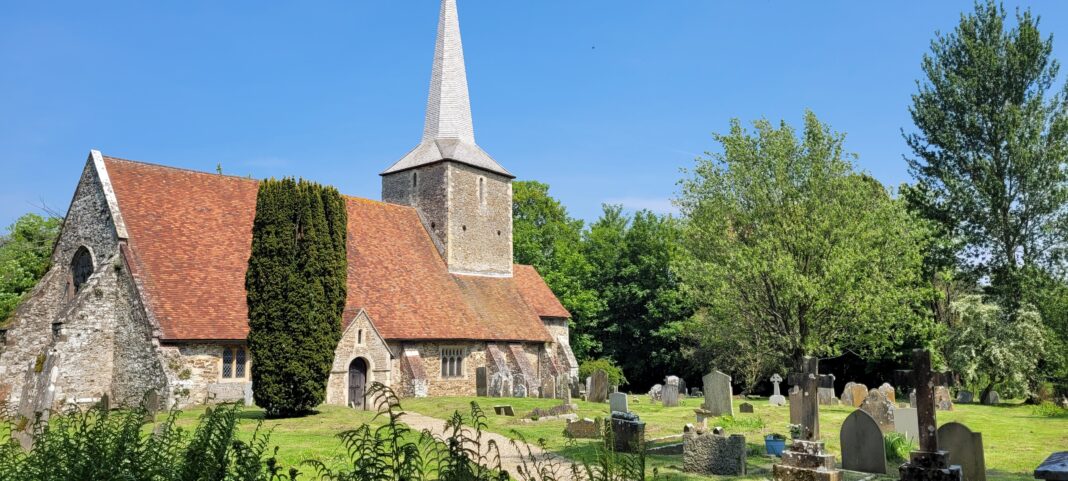Just up the hill from Rye we find the village of Playden. It has an interesting history, seemingly going back as far as 4,000 years. The site was clearly occupied by the time of the Roman occupation of England, as evidenced by the remains of a Roman villa and other artefacts unearthed in the village.
We know that in 1066, before the Norman invasion, the landowner was Ednoth of Playden. In turn he seems to have leased the manor to a man called Siwulf. In common with most land, after 1066 the land was given to one of the supporters of King William I. In the case of Playden – or Pleidena or Plaidenham, spelling was still flexible – it was part of the huge grant of land and property around Rye given to Count Robert of Eu. Under him were Theobald the Priest, Geoffrey, Walter, son of Lambert, Redmir and, once again, Ednoth.
The Domesday Book of 1086 tells us that in 1066 it was worth just £6 a year to Siwulf, but in 1086 was worth £12 and fifteen shillings. There were 37 households, which put it in the top 20% of English villagers by population. Count Robert was listed as owning seven ploughlands, two teams of Lord’s ploughmen, ten and a half men’s plough teams and a five-acre meadow. There was also a church dedicated to St. Michael.
In those early days, Playden was a coastal village, with fishing as its staple industry. To preserve the local catches they were frequently salted, which led to the name of Saltcote being often used locally. The name was for a while recalled in a road called Saltcote Street. Now that is New England Lane. The fishing industry in Playden was so busy that by the 15th century the fishermen of Rye felt that their livelihood was threatened by their neighbours. The changing coastline and withdrawal of the sea put an end to the trade though. The fish market ceases to appear in records after about 1493.
The Saxon period church of St. Michael seems to have been rebuilt in about 1190. Its tall and elegant spire is covered in wooden shingles. At one time it was a familiar landmark for sailors. Inside, under the north arch of there is a fine mediaeval Roodscreen dating from about 1465 and an unusual burial slab. It is of black stone, with carvings of two barrels and a crossed fork and matchstick. These were originally inlaid with brass. The barrels relate to the trade of the man buried there in 1530, Cornelis Roetmans, a Flemish brewer.
Above the chancel arch are the arms of King George III, dated 1787. Displaying such arms was the law in England at one time, to remind the congregation that the Sovereign was Supreme Governor of the Church of England, so they will always postdate the Reformation in the 16 th century.
The present route up the tower is a flight of 85 steps, but on display is a rare survival, a huge ancient wooden ladder leading to the belfry. Woodworm have feasted on it over the years, rendering it too unsafe to use. In the churchyard, lovers of Captain Pugwash will find the grave of his creator, John Ryan.
By the church is a field that was at one time called Beacon Oak Field, because on it during the 15th century a beacon, used for passing on simple messages, once stood. Formed of a barrel of tar in an oak tree, when ablaze it was visible from Tenterden and Alomsbridge. This latter place no longer exists but was near present day Newington Bridge. The tree burnt down in about 1930.
There is another field of two acres called The Butt Field, given by deed of 1703, to the locals in antiquity, for archery practice, recreation and sport. Now it is used, in the main, for grazing. The annual income, about £200, supports the work of the Church of England.
Undoubtedly the most important house in Playden is Saltcote Place, designed in Queen Anne style by Sir Reginald Blomfield, and finished in 1905. It was a wedding present for Captain A Hennessy (of the famous Cognac family, and paid for the French branch of that family.) Building took two years. The house came with 18.5 acres of land, which was used for fruit and vegetables. Enough was produced for the house and for sale, funding the cost of the household staff.
The cypher of the late Queen Elizabeth The Queen Mother is prominently displayed on the house, because Her Late Majesty often stayed with the Hennessy family between the two world wars. During the Second World War, Saltcote Place was Southern Command Headquarters, which led to tank traps called Dragons’ Teeth being installed in the village.
More next week when our history of Playden includes the establishment of a hospital in the middle ages, the forerunner of what is now Rye & Winchelsea District Memorial Hospital.
Image Credits: Juliet Duff .



